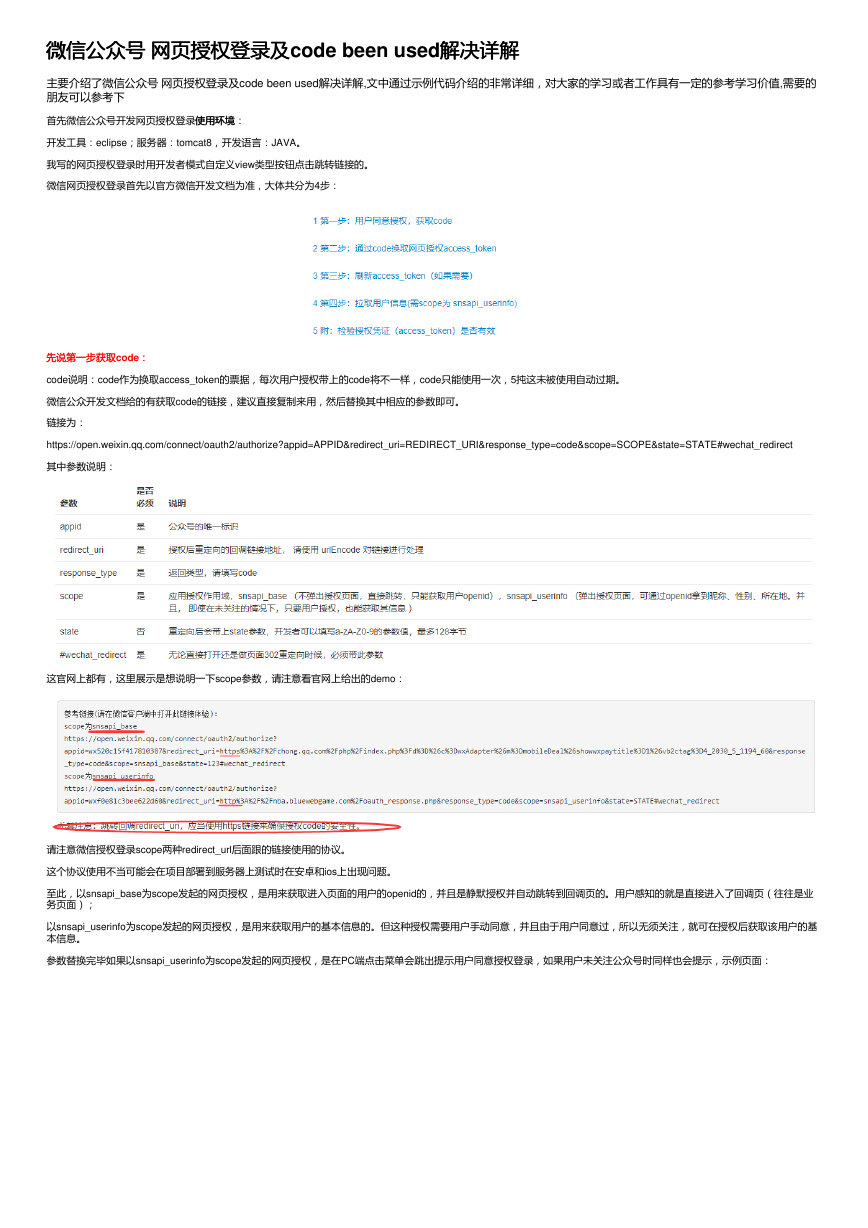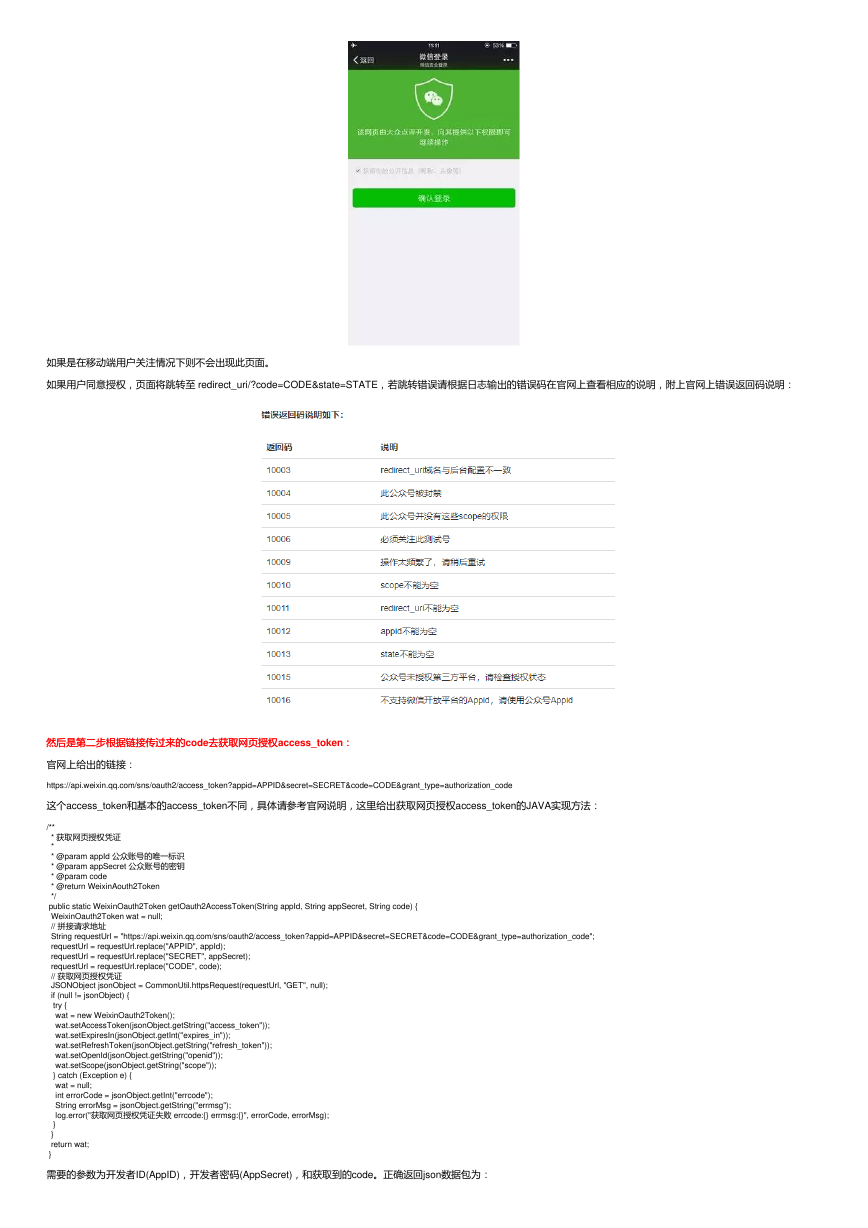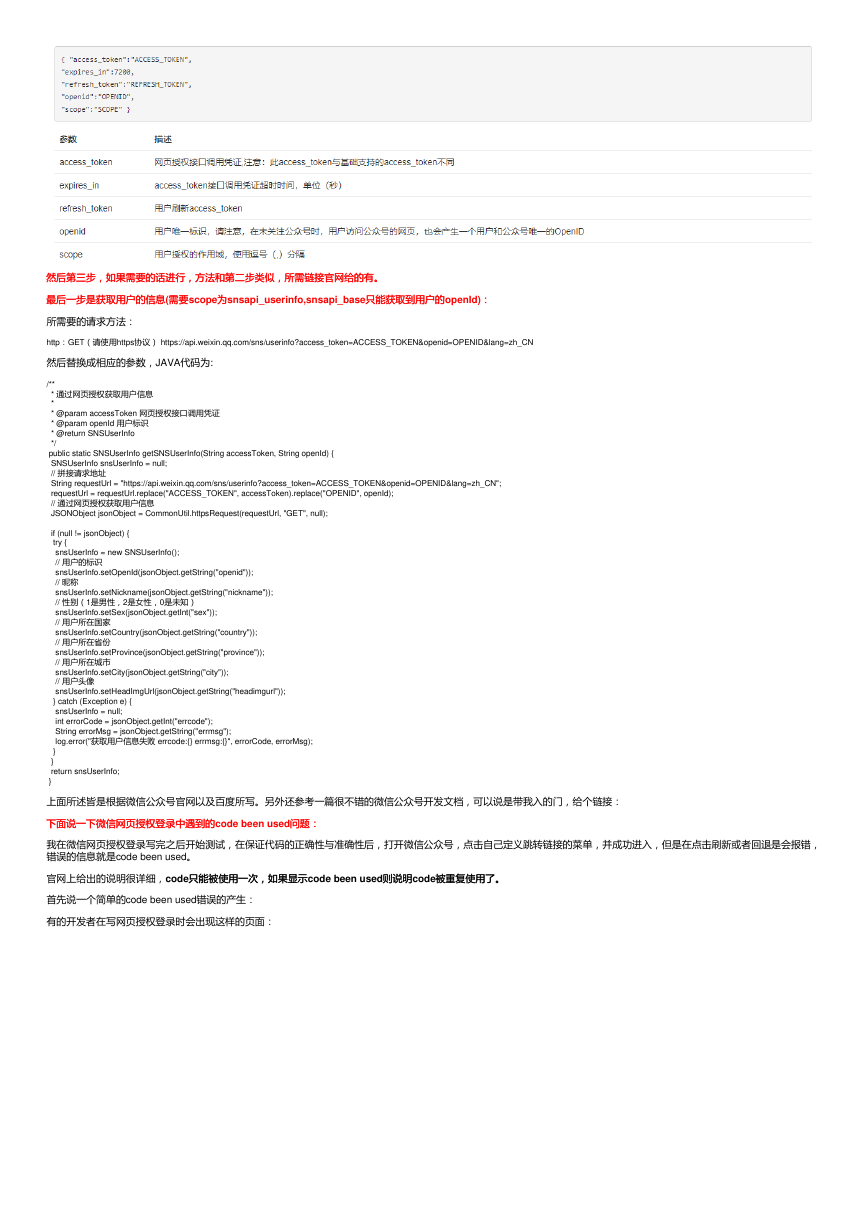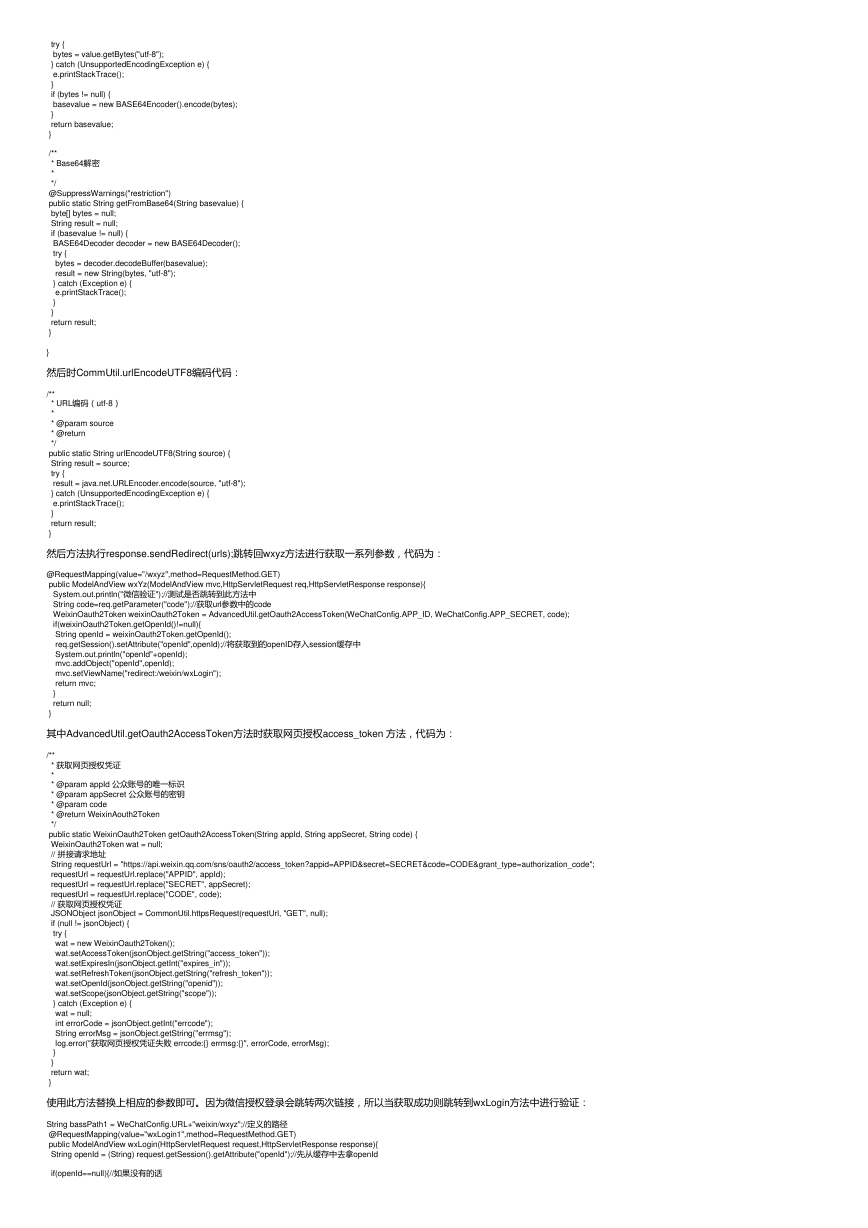网页授权登录及code been used解决详解
解决详解
微信公众号 网页授权登录及
微信公众号
主要介绍了微信公众号 网页授权登录及code been used解决详解,文中通过示例代码介绍的非常详细,对大家的学习或者工作具有一定的参考学习价值,需要的
朋友可以参考下
首先微信公众号开发网页授权登录使用环境
使用环境:
开发工具:eclipse;服务器:tomcat8,开发语言:JAVA。
我写的网页授权登录时用开发者模式自定义view类型按钮点击跳转链接的。
微信网页授权登录首先以官方微信开发文档为准,大体共分为4步:
先说第一步获取code::
先说第一步获取
code说明:code作为换取access_token的票据,每次用户授权带上的code将不一样,code只能使用一次,5扽这未被使用自动过期。
微信公众开发文档给的有获取code的链接,建议直接复制来用,然后替换其中相应的参数即可。
链接为:
https://open.weixin.qq.com/connect/oauth2/authorize?appid=APPID&redirect_uri=REDIRECT_URI&response_type=code&scope=SCOPE&state=STATE#wechat_redirect
其中参数说明:
这官网上都有,这里展示是想说明一下scope参数,请注意看官网上给出的demo:
请注意微信授权登录scope两种redirect_url后面跟的链接使用的协议。
这个协议使用不当可能会在项目部署到服务器上测试时在安卓和ios上出现问题。
至此,以snsapi_base为scope发起的网页授权,是用来获取进入页面的用户的openid的,并且是静默授权并自动跳转到回调页的。用户感知的就是直接进入了回调页(往往是业
务页面);
以snsapi_userinfo为scope发起的网页授权,是用来获取用户的基本信息的。但这种授权需要用户手动同意,并且由于用户同意过,所以无须关注,就可在授权后获取该用户的基
本信息。
参数替换完毕如果以snsapi_userinfo为scope发起的网页授权,是在PC端点击菜单会跳出提示用户同意授权登录,如果用户未关注公众号时同样也会提示,示例页面:
�
如果是在移动端用户关注情况下则不会出现此页面。
如果用户同意授权,页面将跳转至 redirect_uri/?code=CODE&state=STATE,若跳转错误请根据日志输出的错误码在官网上查看相应的说明,附上官网上错误返回码说明:
然后是第二步根据链接传过来的code去获取网页授权
然后是第二步根据链接传过来的
去获取网页授权access_token::
官网上给出的链接:
https://api.weixin.qq.com/sns/oauth2/access_token?appid=APPID&secret=SECRET&code=CODE&grant_type=authorization_code
这个access_token和基本的access_token不同,具体请参考官网说明,这里给出获取网页授权access_token的JAVA实现方法:
/**
* 获取网页授权凭证
*
* @param appId 公众账号的唯一标识
* @param appSecret 公众账号的密钥
* @param code
* @return WeixinAouth2Token
*/
public static WeixinOauth2Token getOauth2AccessToken(String appId, String appSecret, String code) {
WeixinOauth2Token wat = null;
// 拼接请求地址
String requestUrl = "https://api.weixin.qq.com/sns/oauth2/access_token?appid=APPID&secret=SECRET&code=CODE&grant_type=authorization_code";
requestUrl = requestUrl.replace("APPID", appId);
requestUrl = requestUrl.replace("SECRET", appSecret);
requestUrl = requestUrl.replace("CODE", code);
// 获取网页授权凭证
JSONObject jsonObject = CommonUtil.httpsRequest(requestUrl, "GET", null);
if (null != jsonObject) {
try {
wat = new WeixinOauth2Token();
wat.setAccessToken(jsonObject.getString("access_token"));
wat.setExpiresIn(jsonObject.getInt("expires_in"));
wat.setRefreshToken(jsonObject.getString("refresh_token"));
wat.setOpenId(jsonObject.getString("openid"));
wat.setScope(jsonObject.getString("scope"));
} catch (Exception e) {
wat = null;
int errorCode = jsonObject.getInt("errcode");
String errorMsg = jsonObject.getString("errmsg");
log.error("获取网页授权凭证失败 errcode:{} errmsg:{}", errorCode, errorMsg);
}
}
return wat;
}
需要的参数为开发者ID(AppID),开发者密码(AppSecret),和获取到的code。正确返回json数据包为:
�
然后第三步,如果需要的话进行,方法和第二步类似,所需链接官网给的有。
然后第三步,如果需要的话进行,方法和第二步类似,所需链接官网给的有。
最后一步是获取用户的信息(需要需要scope为为snsapi_userinfo,snsapi_base只能获取到用户的
最后一步是获取用户的信息
只能获取到用户的openId)::
所需要的请求方法:
http:GET(请使用https协议) https://api.weixin.qq.com/sns/userinfo?access_token=ACCESS_TOKEN&openid=OPENID&lang=zh_CN
然后替换成相应的参数,JAVA代码为:
/**
* 通过网页授权获取用户信息
*
* @param accessToken 网页授权接口调用凭证
* @param openId 用户标识
* @return SNSUserInfo
*/
public static SNSUserInfo getSNSUserInfo(String accessToken, String openId) {
SNSUserInfo snsUserInfo = null;
// 拼接请求地址
String requestUrl = "https://api.weixin.qq.com/sns/userinfo?access_token=ACCESS_TOKEN&openid=OPENID&lang=zh_CN";
requestUrl = requestUrl.replace("ACCESS_TOKEN", accessToken).replace("OPENID", openId);
// 通过网页授权获取用户信息
JSONObject jsonObject = CommonUtil.httpsRequest(requestUrl, "GET", null);
if (null != jsonObject) {
try {
snsUserInfo = new SNSUserInfo();
// 用户的标识
snsUserInfo.setOpenId(jsonObject.getString("openid"));
// 昵称
snsUserInfo.setNickname(jsonObject.getString("nickname"));
// 性别(1是男性,2是女性,0是未知)
snsUserInfo.setSex(jsonObject.getInt("sex"));
// 用户所在国家
snsUserInfo.setCountry(jsonObject.getString("country"));
// 用户所在省份
snsUserInfo.setProvince(jsonObject.getString("province"));
// 用户所在城市
snsUserInfo.setCity(jsonObject.getString("city"));
// 用户头像
snsUserInfo.setHeadImgUrl(jsonObject.getString("headimgurl"));
} catch (Exception e) {
snsUserInfo = null;
int errorCode = jsonObject.getInt("errcode");
String errorMsg = jsonObject.getString("errmsg");
log.error("获取用户信息失败 errcode:{} errmsg:{}", errorCode, errorMsg);
}
}
return snsUserInfo;
}
上面所述皆是根据微信公众号官网以及百度所写。另外还参考一篇很不错的微信公众号开发文档,可以说是带我入的门,给个链接:
下面说一下微信网页授权登录中遇到的code been used问题:问题:
下面说一下微信网页授权登录中遇到的
我在微信网页授权登录写完之后开始测试,在保证代码的正确性与准确性后,打开微信公众号,点击自己定义跳转链接的菜单,并成功进入,但是在点击刷新或者回退是会报错,
错误的信息就是code been used。
官网上给出的说明很详细,code只能被使用一次,如果显示
只能被使用一次,如果显示code been used则说明则说明code被重复使用了。
被重复使用了。
首先说一个简单的code been used错误的产生:
有的开发者在写网页授权登录时会出现这样的页面:
�
这是在微信开发公众号上没有配置安全域名,导致微信网页授权登录时会显示这样的页面,url跳转了两次,传入的code被重复使用了,遇到这种的可以现在微信开发公众号里面
配置安全域名。
然后说普遍遇到的code been used问题。问题。
然后说普遍遇到的
基本思路时:当我点击菜单按钮进入页面时,先去sssion缓存中去那由code获取到的openId,如果openId不存在,则证明code为首次使用,可以根据传过来的code获取相应的
access_token和openId。
如果存在,则直接使用获取到的openId去获取用户的一系列信息。
我用的时springMVC,简单实现代码为:
首先在开发者定义的菜单路径上配置域名和跳转的控制器方法:
前面模糊的是自己配置的域名,后面/weixin/redirect则是要跳转的方法。
跳转到的方法为:
JAVA代码:
/**获取用户openId
* @throws IOException */
@RequestMapping(value = "/redirect", method = RequestMethod.GET)
public ModelAndView repairs(ModelAndView mav, HttpServletRequest request, HttpServletResponse resp) throws IOException{
String openId = (String) request.getSession().getAttribute("openId");//先从缓存中获取通过code得到的openID
System.out.println(openId);//测试输出openId
if(openId==null){//判断openId是否为空(判断code是否为第一次被使用)
RedirectUtils.redireUrl1(request, resp);//openid为空也就是code被第一次使用时跳转方法
return null;
}
mav.addObject("openId",openId);//没有被使用时
mav.setViewName("/weixin/repairs");//返回要跳转的视图页面
return mav;
}
RedirectUtils.redireUrl1(request, resp);为重定向跳转的路径。JAVA代码:
public static void redireUrl1(HttpServletRequest request,HttpServletResponse response){
System.out.println("跳转");//测试是否跳转过来了
String a="";
if(request.getQueryString()!=null){
a="?"+request.getQueryString();
}
String url = Base64.getBase64(request.getRequestURL()+a);//此为链接中带的一些参数 不需要可以不用写
System.out.println(request.getRequestURL()+a);
String basePath = WeChatConfig.URL+"weixin/wxyz?url="+url;//redirect_uri地址
System.out.println(basePath);
String urls="https://open.weixin.qq.com/connect/oauth2/authorize?appid=" + WeChatConfig.APP_ID+
"&redirect_uri=" + CommonUtil.urlEncodeUTF8(basePath)+
"&response_type=code" +
"&scope=snsapi_userinfo" +
"&state=STATE#wechat_redirect";
try {
response.sendRedirect(urls);//重定向执行url
}catch(Exception e){
e.printStackTrace();
}
}
其中Base64.getBase64为Base64加密方法,WeChatConfig.URL为你自己微信公众平台配置的安全域名,CommUtil.urlEncodeUTF8对重定向链接进行编码。
提供一下Base64方法中的加密解密方法,请先下载相应的jar包:
**
* Base64工具 CREATE 2016.12.14 form yjf
*
*/
public class Base64 {
/**
* Base64加密
*
*/
@SuppressWarnings("restriction")
public static String getBase64(String value) {
byte[] bytes = null;
String basevalue = null;
�
try {
bytes = value.getBytes("utf-8");
} catch (UnsupportedEncodingException e) {
e.printStackTrace();
}
if (bytes != null) {
basevalue = new BASE64Encoder().encode(bytes);
}
return basevalue;
}
/**
* Base64解密
*
*/
@SuppressWarnings("restriction")
public static String getFromBase64(String basevalue) {
byte[] bytes = null;
String result = null;
if (basevalue != null) {
BASE64Decoder decoder = new BASE64Decoder();
try {
bytes = decoder.decodeBuffer(basevalue);
result = new String(bytes, "utf-8");
} catch (Exception e) {
e.printStackTrace();
}
}
return result;
}
}
然后时CommUtil.urlEncodeUTF8编码代码:
/**
* URL编码(utf-8)
*
* @param source
* @return
*/
public static String urlEncodeUTF8(String source) {
String result = source;
try {
result = java.net.URLEncoder.encode(source, "utf-8");
} catch (UnsupportedEncodingException e) {
e.printStackTrace();
}
return result;
}
然后方法执行response.sendRedirect(urls);跳转回wxyz方法进行获取一系列参数,代码为:
@RequestMapping(value="/wxyz",method=RequestMethod.GET)
public ModelAndView wxYz(ModelAndView mvc,HttpServletRequest req,HttpServletResponse response){
System.out.println("微信验证");//测试是否跳转到此方法中
String code=req.getParameter("code");//获取url参数中的code
WeixinOauth2Token weixinOauth2Token = AdvancedUtil.getOauth2AccessToken(WeChatConfig.APP_ID, WeChatConfig.APP_SECRET, code);
if(weixinOauth2Token.getOpenId()!=null){
String openId = weixinOauth2Token.getOpenId();
req.getSession().setAttribute("openId",openId);//将获取到的openID存入session缓存中
System.out.println("openId"+openId);
mvc.addObject("openId",openId);
mvc.setViewName("redirect:/weixin/wxLogin");
return mvc;
}
return null;
}
其中AdvancedUtil.getOauth2AccessToken方法时获取网页授权access_token 方法,代码为:
/**
* 获取网页授权凭证
*
* @param appId 公众账号的唯一标识
* @param appSecret 公众账号的密钥
* @param code
* @return WeixinAouth2Token
*/
public static WeixinOauth2Token getOauth2AccessToken(String appId, String appSecret, String code) {
WeixinOauth2Token wat = null;
// 拼接请求地址
String requestUrl = "https://api.weixin.qq.com/sns/oauth2/access_token?appid=APPID&secret=SECRET&code=CODE&grant_type=authorization_code";
requestUrl = requestUrl.replace("APPID", appId);
requestUrl = requestUrl.replace("SECRET", appSecret);
requestUrl = requestUrl.replace("CODE", code);
// 获取网页授权凭证
JSONObject jsonObject = CommonUtil.httpsRequest(requestUrl, "GET", null);
if (null != jsonObject) {
try {
wat = new WeixinOauth2Token();
wat.setAccessToken(jsonObject.getString("access_token"));
wat.setExpiresIn(jsonObject.getInt("expires_in"));
wat.setRefreshToken(jsonObject.getString("refresh_token"));
wat.setOpenId(jsonObject.getString("openid"));
wat.setScope(jsonObject.getString("scope"));
} catch (Exception e) {
wat = null;
int errorCode = jsonObject.getInt("errcode");
String errorMsg = jsonObject.getString("errmsg");
log.error("获取网页授权凭证失败 errcode:{} errmsg:{}", errorCode, errorMsg);
}
}
return wat;
}
使用此方法替换上相应的参数即可。因为微信授权登录会跳转两次链接,所以当获取成功则跳转到wxLogin方法中进行验证:
String bassPath1 = WeChatConfig.URL+"weixin/wxyz";//定义的路径
@RequestMapping(value="wxLogin1",method=RequestMethod.GET)
public ModelAndView wxLogin(HttpServletRequest request,HttpServletResponse response){
String openId = (String) request.getSession().getAttribute("openId");//先从缓存中去拿openId
if(openId==null){//如果没有的话
�
String url="https://open.weixin.qq.com/connect/oauth2/authorize?appid=" + WeChatConfig.APP_ID +
"&redirect_uri=" + CommonUtil.urlEncodeUTF8(bassPath1)+
"&response_type=code" +
"&scope=snsapi_userinfo" +
"&state=STATE#wechat_redirect";
try {
response.sendRedirect(url);
} catch (IOException e) {
e.printStackTrace();
}
}else{
return new ModelAndView("weixin/repairs");//返回页面
}
return null;
}
至此,打开所需要的页面,无论时第一次进入还是刷新 都不会出现code been used这种情况了,至少本人测试没有出现过。
以上就是本文的全部内容,希望对大家的学习有所帮助,也希望大家多多支持我们。
�












 2023年江西萍乡中考道德与法治真题及答案.doc
2023年江西萍乡中考道德与法治真题及答案.doc 2012年重庆南川中考生物真题及答案.doc
2012年重庆南川中考生物真题及答案.doc 2013年江西师范大学地理学综合及文艺理论基础考研真题.doc
2013年江西师范大学地理学综合及文艺理论基础考研真题.doc 2020年四川甘孜小升初语文真题及答案I卷.doc
2020年四川甘孜小升初语文真题及答案I卷.doc 2020年注册岩土工程师专业基础考试真题及答案.doc
2020年注册岩土工程师专业基础考试真题及答案.doc 2023-2024学年福建省厦门市九年级上学期数学月考试题及答案.doc
2023-2024学年福建省厦门市九年级上学期数学月考试题及答案.doc 2021-2022学年辽宁省沈阳市大东区九年级上学期语文期末试题及答案.doc
2021-2022学年辽宁省沈阳市大东区九年级上学期语文期末试题及答案.doc 2022-2023学年北京东城区初三第一学期物理期末试卷及答案.doc
2022-2023学年北京东城区初三第一学期物理期末试卷及答案.doc 2018上半年江西教师资格初中地理学科知识与教学能力真题及答案.doc
2018上半年江西教师资格初中地理学科知识与教学能力真题及答案.doc 2012年河北国家公务员申论考试真题及答案-省级.doc
2012年河北国家公务员申论考试真题及答案-省级.doc 2020-2021学年江苏省扬州市江都区邵樊片九年级上学期数学第一次质量检测试题及答案.doc
2020-2021学年江苏省扬州市江都区邵樊片九年级上学期数学第一次质量检测试题及答案.doc 2022下半年黑龙江教师资格证中学综合素质真题及答案.doc
2022下半年黑龙江教师资格证中学综合素质真题及答案.doc